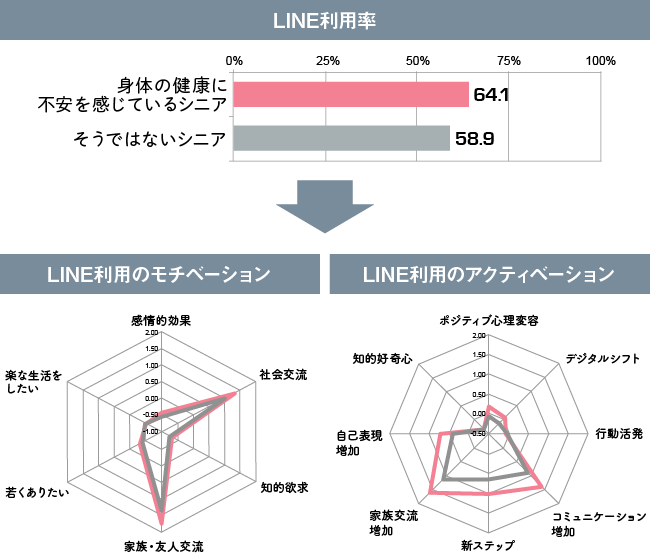In 2016, the proportion of the population aged 65 and over was 27.3%. By 2025, this will exceed 30% and continue to rise. The average life expectancy for both men and women has already exceeded 80 years (※1). In the future Japanese society, people must design their lives assuming they will live into their 70s and beyond.
The role of digital technology in enhancing the quality of extended senior life will only grow more significant. However, many digital services, primarily centered around smartphones, are evaluated from a younger generation's perspective, with little discussion of their actual contribution to senior life. Is digital technology truly making seniors happier?
※1 Cabinet Office, 2017 White Paper on Aging Society
What do seniors seek from digital technology, and what do they gain?
When considering digital technology and senior happiness, Dentsu Inc. Media Innovation Lab focused on seniors' "pleasures" and "worries."While broadly termed "seniors," their circumstances vary greatly—economic status, health, family ties, social networks. Rather than demographic attributes, we examined how seniors with diverse daily "pleasures" and "worries" use digital services based on their motivations (motivation), and what psychological and behavioral changes (activation) result. This article clarifies the contribution of digital services to senior life based on this experiential survey.
Facebook for Enjoying Hobbies and Connecting with Friends
Figure 1 summarizes Facebook usage among seniors who "enjoy interacting with others through hobbies" (※2) as part of their daily pleasures. It compares the scores of these seniors with those who do not share this hobby-based interaction, examining three perspectives: usage rate, motivation for use, and psychological/behavioral changes (activation) resulting from use.
※2 Seniors who primarily responded that they feel happy in daily life during activities such as "when interacting with people who share the same hobbies or sports," "when immersed in hobbies or sports," or "when others see the results of their hobbies or sports."
Figure 1

Bar graph: Factor scores for "Enjoying social interaction with others through hobbies" derived from factor analysis of seniors' daily enjoyment.
scores above the mean were defined as "Seniors who enjoy interacting with others through hobbies," while those below the mean were defined as
"Seniors who do not enjoy this."
Radar Chart: The values in each graph represent the factor scores for the six types of "Motivation Factors" and the eight types of "Activation Factors" obtained from the factor analysis.
factors" and eight types of "activation factors" derived from factor analysis.
Seniors who enjoy interacting with others through hobbies use Facebook more frequently than those who do not. As a result of this usage, it leads to increased activation in various areas such as communication, taking new steps, and self-expression.
For seniors who enjoy interacting with others through hobbies, Facebook functions as a fun social space, much like club activities during their student days. For seniors who may become less outgoing or more withdrawn with age, the benefits of such social media are particularly significant.
LINE: Connecting with Family to Ease Anxiety
Digital tools also contribute to seniors facing challenges. Figure 2 summarizes LINE usage among seniors who "feel anxious about their physical health" (※3). Seniors with health concerns show a high LINE usage rate. Their motivation for using LINE strongly reflects a desire for family and friend interaction, and they report feeling that family communication has actually increased. By providing a means for constant communication with family, LINE appears to alleviate seniors' anxieties.
※3 Seniors who primarily responded that they are troubled by items such as "feeling physical decline recently," "feeling memory decline," or "feeling unwell even though not sick" in daily life.
Figure 2

Bar Chart: Factor scores for "Physical/Health Anxiety" derived from factor analysis of seniors' daily concerns.
or above are defined as "seniors experiencing physical health anxiety," while those below the average are defined as "seniors not experiencing such anxiety."
.
Radar Chart: The values in each graph represent the factor scores for the six types of "Motivation Factors" and the eight types of "Activation Factors" derived from the factor analysis.
factors" and eight types of "activation factors" derived from factor analysis.
Households consisting of single individuals or couples only accounted for less than 30% combined in 1980, but increased to 55.4% by 2014 (※4). For many seniors, family members are not necessarily always present.
※ 4 Cabinet Office, 2017 White Paper on Aging Society
Unlike phone calls, instant messengers don't unilaterally tie up the other person. For seniors who don't want to burden their families but still wish to stay emotionally connected, the pacing of instant messengers might be just right.
Creating a Place for Oneself on Instagram
Figure 3 examines Instagram usage among seniors who feel they lack a "place to belong" in their lives (※5). Seniors with such concerns use Instagram more frequently. They also use it with motivations distinct from Facebook or LINE, such as wanting to feel happy or stay young. As a result of their usage, positive psychological changes (feeling happy), taking new steps, and self-expression (activation) increase. Through Instagram, we can see them opening up new worlds.
※5 Seniors who primarily reported struggling with items such as "unaccustomed to workplace environment or relationships," "wanting to quit work," or "no sense of belonging at home" in daily life.
Figure 3

Bar graph: Seniors whose factor scores for "loss of place"—derived from factor analysis of daily concerns—were above average
defined as "seniors troubled by a lack of belonging," while scores below the average defined as "seniors not troubled by a lack of belonging."
Radar Chart: The values in each graph represent the factor scores for the six types of "Motivation Factors" and the eight types of "Activation Factors" derived from the factor analysis.
factors" and eight types of "activation factors" derived from factor analysis.
When friends and acquaintances react to photos you've carefully crafted yourself with likes or comments.Instagram photo posting brings the joy of being affirmed. In the same survey, when seniors were asked why they give "likes," the highest percentage cited "to compliment the other person" on Instagram (※6). It seems a surprisingly large number of seniors find encouragement in positive reactions to their posted photos. For some seniors, social media may be an irreplaceable source that can even connect to a sense of purpose.
※6 Percentage of respondents who " like " others' posts because "they want to praise the person"
Instagram 38.1% Facebook 35.3% Twitter 25.9%
Focusing on seniors' joys and concerns reveals the positive impact social media can have on them. These aspects connect to challenges in an aging society, such as social interaction, family relationships, and finding purpose.
As Japan's aging population continues to grow, the role of digital technology will remain a critical question.
Digital technology isn't just for young people. We look forward to the development of digital services that engage with seniors.
[Survey Overview]
Dentsu Inc. Media Innovation Lab
"Survey on App/Service and SNS Usage Among Senior Digital Users"
Survey Purpose: To understand the actual usage of social media, apps, and internet services among seniors. Also, to analyze how the use of apps and services impacts various aspects of seniors' lives.
Survey Period: August 2017
Survey Method: Internet survey
Survey Participants: 2,146 men and women aged 55 to 74 nationwide
To gain insights into digital app and service usage, seniors with a certain level of digital familiarity were screened.
Screening Criteria:
① Uses at least two devices (PC [desktop/laptop], tablet, smartphone) once or more per day
② Use of 5 to 30 of the surveyed apps/services.
Seniors meeting both criteria ① and ② were selected as survey participants.











